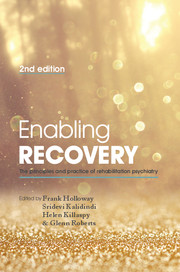Book contents
- Frontmatter
- Contents
- List of contributors
- List of figures, tables and boxes
- Preface
- Part 1 Setting the scene
- Part 2 Treatment approaches
- Part 3 Key elements of a rehabilitation service
- Part 4 Special topics in psychiatric rehabilitation
- 23 Special topics in psychiatric rehabilitation: overview
- 24 Rehabilitation and acquired brain injury
- 25 Autism spectrum disorder
- 26 Risk management in rehabilitation practice
- 27 Rehabilitation: an international perspective
- 28 Psychosocial rehabilitation across culture: the experience in low- and middle-income countries
- 29 Expanding the evidence base
- Part 5 Future directions
- Index
26 - Risk management in rehabilitation practice
from Part 4 - Special topics in psychiatric rehabilitation
Published online by Cambridge University Press: 02 January 2018
- Frontmatter
- Contents
- List of contributors
- List of figures, tables and boxes
- Preface
- Part 1 Setting the scene
- Part 2 Treatment approaches
- Part 3 Key elements of a rehabilitation service
- Part 4 Special topics in psychiatric rehabilitation
- 23 Special topics in psychiatric rehabilitation: overview
- 24 Rehabilitation and acquired brain injury
- 25 Autism spectrum disorder
- 26 Risk management in rehabilitation practice
- 27 Rehabilitation: an international perspective
- 28 Psychosocial rehabilitation across culture: the experience in low- and middle-income countries
- 29 Expanding the evidence base
- Part 5 Future directions
- Index
Summary
Introduction
‘Risk’, as a noun, implies a danger of ‘loss, injury or other adverse circumstances’ or ‘commercial loss’ (Shorter Oxford English Dictionary). In mental healthcare the ‘injury’ or ‘loss’ clearly applies to the service user or to others, or to both, caused by the service user, or inflicted upon the service user owing to that user's vulnerability. For professionals and healthcare organisations, risk has an additional element: the financial and reputational consequences of something being perceived as having gone wrong. Risk management involves attempts at both minimising the harms experienced by service users and others and the potential for reputational risk or blame. Our focus is on how to minimise harm, but it has to be acknowledged that many of the risk management practices, policies and procedures adopted by mental health services primarily work to decrease the potential for blame.
While media attention is skewed towards concerns about the risks that service users might pose to others, the reality remains that users are more likely to pose a risk to themselves or be the victim of violence and aggression than to engage in serious violence. Rehabilitation practitioners will be aware of the risks of vulnerability and of service users being exploited by others. Risk, in the sense of trying things out, is part of everyday living and inherent in every life choice and decision. Learning from experience reinforces self-confidence, capacity and coping skills, all necessary components of rehabilitation, and consequently supported risktaking can foster recovery and personal development. It follows that the focus of risk assessment and management should be on safety enhancement rather than risk reduction (Morgan, 2007).
Service users are referred to rehabilitation services not only because of treatment resistance, chronicity or their complex needs (many patients in contact with generic services and living in the community have these characteristics) but also because of concerns about safety/risk as a consequence of these factors. Safety is a key issue when considering admission to or discharge from rehabilitation services and deciding what support a service user requires in the community.
Information
- Type
- Chapter
- Information
- Enabling Recovery , pp. 391 - 408Publisher: Royal College of PsychiatristsPrint publication year: 2015
